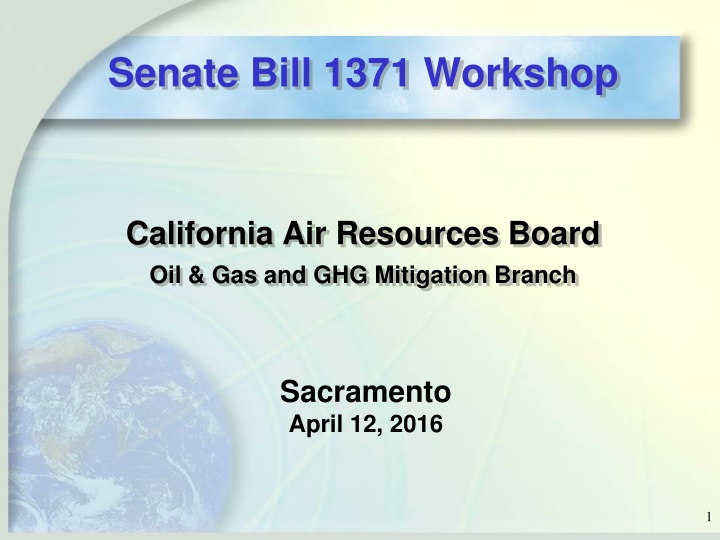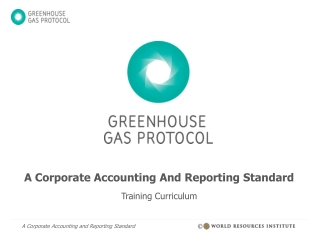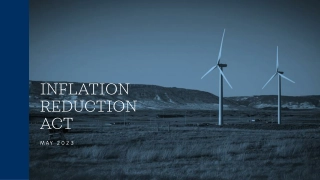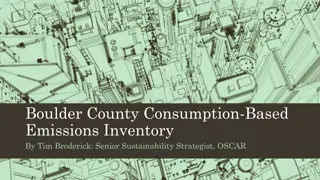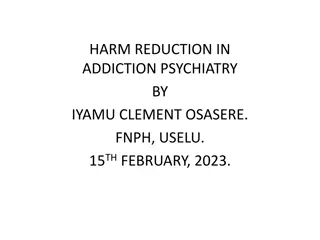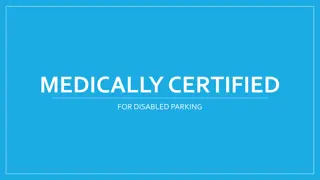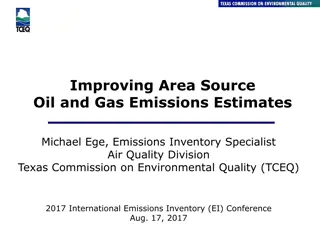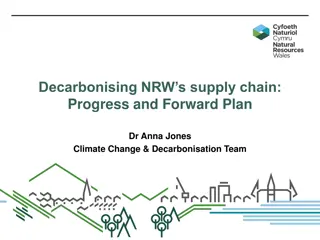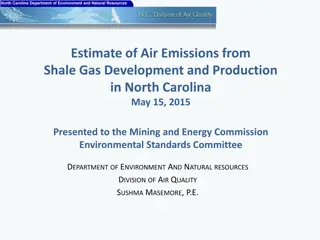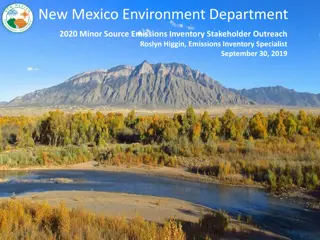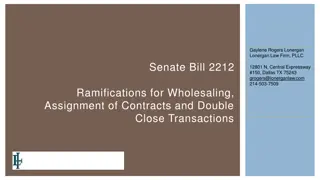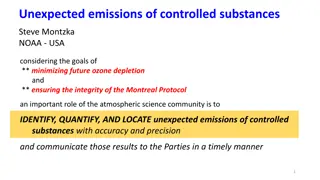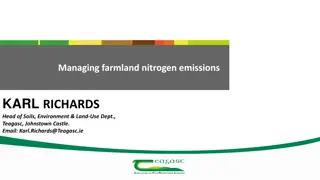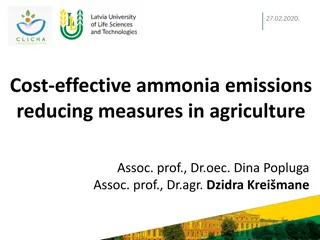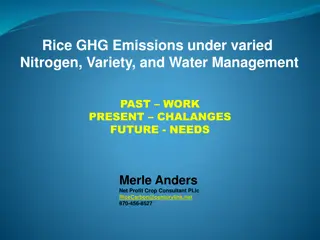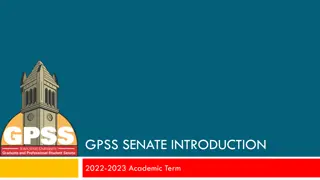Senate Bill 1371 Workshop on Emissions Reduction Strategies
This workshop hosted by the California Air Resources Board focused on setting emissions reduction targets, industry practices, and strategies to achieve a 40% reduction below set benchmarks. Discussions included different target approaches, prioritizing environmental justice, and compliance enforcement.
Download Presentation

Please find below an Image/Link to download the presentation.
The content on the website is provided AS IS for your information and personal use only. It may not be sold, licensed, or shared on other websites without obtaining consent from the author.If you encounter any issues during the download, it is possible that the publisher has removed the file from their server.
You are allowed to download the files provided on this website for personal or commercial use, subject to the condition that they are used lawfully. All files are the property of their respective owners.
The content on the website is provided AS IS for your information and personal use only. It may not be sold, licensed, or shared on other websites without obtaining consent from the author.
E N D
Presentation Transcript
Senate Bill 1371 Workshop California Air Resources Board Oil & Gas and GHG Mitigation Branch Sacramento April 12, 2016 1
Agenda 9:30 Introduction 9:45 ARB Presentation 10:30 CPUC Presentation 11:15 EDF Presentation 12:00 Lunch 1:00 Sempra Presentation 1:45 PG&E Presentation 2:30 Break 2:45 ISPs Presentation 3:30 Next Steps 4:00 Adjourn 2
Topics How should the targets be set up? Industry wide; By company; or By emission source/equipment type. Should small utilities have a different target? Should storage companies have a different target? How can we go further than a 40% reduction? Should there be interim targets? How does your company plan to prioritize emission reductions in Environmental Justice (EJ) or Disadvantaged Communities? 3
Outline Emissions Target Emission Sources Best Practices Compliance Enforcement Environmental Justice Next Steps 4
Emissions Target Executive Order B-30-15: 40 percent GHG reduction below 1990 levels by 2030 ARB Short Lived Climate Pollutant Plan: 40-45 percent GHG reduction below 2012 levels by 2025 Similar to U.S. EPA goals Harmonizing both targets Potential reductions beyond the above targets 5
How To Achieve Emissions Target? Options: Industry-wide Per company By system or emissions source category Considerations: Small companies Certain activities 6
Types of Emissions Graded Leaks hazardous or could potentially become hazardous Vented Emissions gas release due to operation/maintenance Ungraded Leaks Remaining non-hazardous leaks (e.g., above ground, remote location) 7
Emission Data Reports (May 15, 2015) Calendar Year NG Volume (Bscf) CO2 Mass [MMTCO2e]* 2014 (SB 1371) 3.9 5.4 2013 (SB 1371) 3.8 5.3 2007 8.2 11.3 (ARB Survey) *IPCC, AR 4, 20-yr horizon, GWP = 72 8
Major Sources of Emissions, 2014 1% 3% 15% 32% 24% 26% Source: SB 1371, May 2015 Emission Data Reports 9
Data Discrepancies No standardized emission factors (EFs) No comprehensive activity data Not all emission sources reported Others: Metering accuracies Incorrect units: activities or EFs Gas losses: own use, temp. adjustment & theft 10
New Reporting Templates Baseline emission inventory CY 2015 Comprehensive emission sources System-wide extrapolation Unusual large leaks Standardized emission factors Widely used by the industry Update periodically California specific 11
California Specific EFs Updating EFs for distribution pipelines (completed): Gas Technology Institute, contractor ($250K) Measured 78 leaks in CA (GRI 1996, nationwide, 43 leaks ) Unprotected steel and plastic pipelines Both above and below ground measurements ARB evaluating the results: some lower and some higher than GRI 1996 Updating EFs for customer meters (in process): Gas Technology Institute, contractor ($150K) Random sample of 500 households throughout the State Measure and identify leak sources Tentative starting date, August, 2016 12
Best Practices (BPs) CPUC, in consultation with ARB, to Establish and require the use of BPs for Leak surveys Leak patrols Leak prevention Leak reduction Require BPs and repair standards be incorporated into the safety plans 13
(contd) CPUC formed BP working group: Utility companies Independent storage providers Labor unions Environmental community Five workgroup meetings: Oct 2015 - Jan 2016. 100+ BPs presented Some BPs already implemented Other BPs follow in the future 14
BPs Selection Criteria Target Low Hanging Fruit Adopt new leak detection technologies Incorporate industry s policies, training & education Use better emissions quantification/characterization & repairs coordination Combine industry standards for both public and environmental safeties Consider incentives for reductions beyond the emission targets 15
Recommended BPs Recommended BPs are categorized into: Mandatory BPs: Minimum requirements to mitigate emissions Voluntary BPs: Additional requirements from the presented or new BPs Consistent with or complementary to other regulations State: DOGGR and ARB Federal: U.S. EPA 16
Some Examples of BPs Emission Source Recommended BPs* -Use better materials -Automatic detection: Smart Meters -Update emission factors (Proposed GTI study, $150K) -Capture large releases from point source -Replace susceptible materials (phase out cast iron) -More frequent inspection, using new tech detection -Shorten repair time: Find It, Fix It, policy -Update emission factors (Completed GTI study, under evaluation) -Reroute blowdown gas -Replace wet with dry seals (Oil & Gas Regulation) -Use no bleeds -Consider additional requirements, if any, to prevent future leaks beyond DOGGR & ARB regulations -Employ LDAR (Leak Detection and Repair) for above ground facilities Customer meters Blowdowns Pipeline leaks Compressors Pneumatics Gas Storage All Sources 17 *Red = Mandatory BPs
Compliance Submit annual compliance plan to CPUC/ARB Starting May 2018 (?) Emission reductions must be real & verifiable Agreeable methodologies Work order or maintenance records Purchase records Unfulfilled emission target must be offset 18
An Example of Compliance Plan A 40+ percent reduction by 2025 (SB 1371 May 2015 data reports, CY 2014) (percent) 30 90% 80% 25 60% 20 Reduction Remaining 15 10 50% 75% 5 40% 25% 0 Customer Meters Blowdowns Pipeline Leaks M&R Stations Compressor Stations Dig-ins Leaks Others 19
Unusual Large Leaks Definition: Any event at a gas storage facility or gas transmission system that results in the uncontrollable release of natural gas to the atmosphere for more than 24 hours. Review current practices to prevent future occurrence Additional emissions to annual compliance plans Must be offset in certain time period Could face financial penalty 20
Enforcement CPUC will conduct unannounced random inspection Industry must provide prior notification to CPUC/ARB Large blowdown, compressor station modification At least two weeks in advance, unless for emergency reasons 21
Environmental Justice Prioritize EJ / disadvantaged communities Mapping of leaks by GIS Responding to complaints Replacing old pipe materials, meters Progress on SLCPs and the importance of reducing fugitive methane emissions: http://www.arb.ca.gov/cc/ejac/meetings/041014/final_ejac_recommendations.pdf http://www.arb.ca.gov/cc/ejac/meetings/041014/appendix_a.pdf 22
Next Steps Finalize BPs Report Review new data submittals Next workshop Others? 23
Discussion Questions or Comments? 24
ARB Points of Contact Elizabeth Scheehle, Chief Win Setiawan, Lead Oil & Gas and GHG Mitigation Branch Staff Air Pollution Specialist escheehl@arb.ca.gov wsetiawa@arb.ca.gov (916)322-7630 (916)322-7630 Terrel Ferreira, Manager Andrew Mrowka GHG Measures Section Air Resources Engineer tferreir@arb.ca.gov amrowka@arb.ca.gov (916)445-3526 (916)324-0330 25
